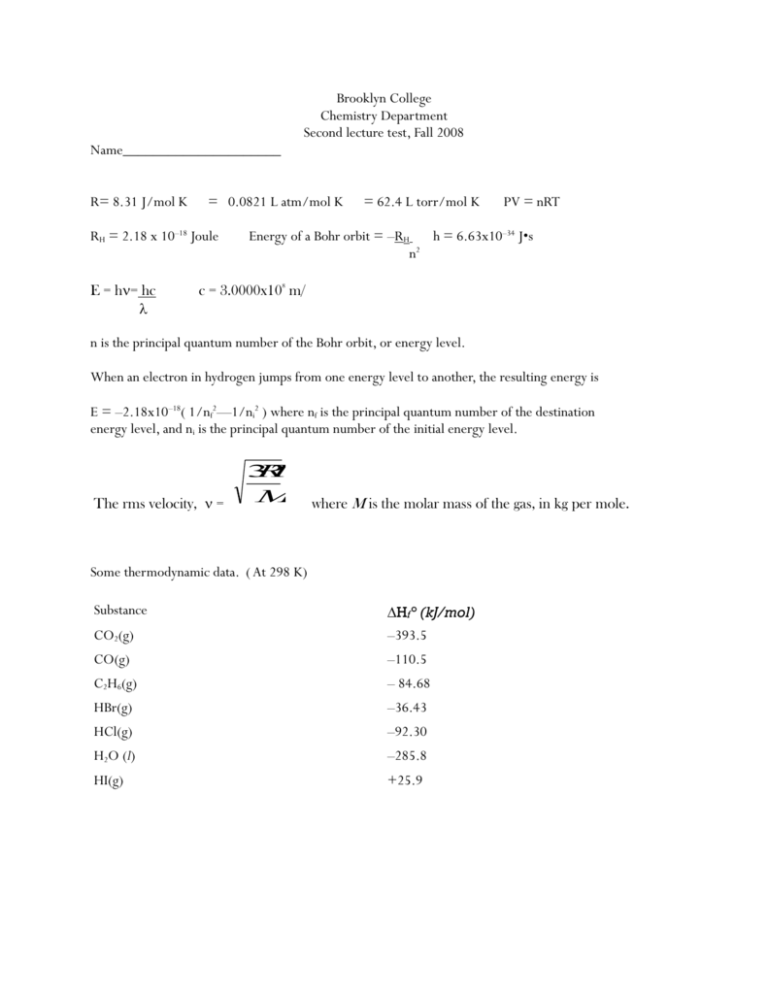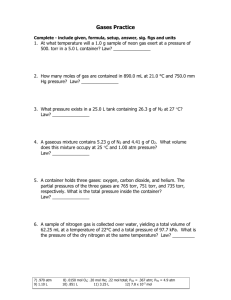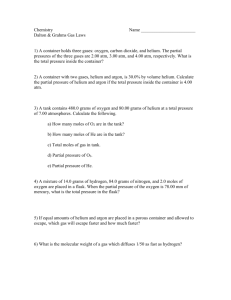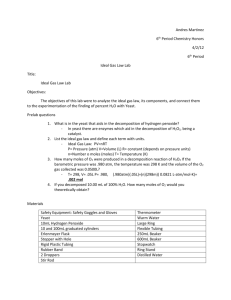File
advertisement

Brooklyn College Chemistry Department Second lecture test, Fall 2008 Name_____________________ R= 8.31 J/mol K = 0.0821 L atm/mol K RH = 2.18 x 10–18 Joule E = h= hc = 62.4 L torr/mol K PV = nRT Energy of a Bohr orbit = –RH h = 6.63x10–34 J•s n2 c = 3.0000x108 m/ n is the principal quantum number of the Bohr orbit, or energy level. When an electron in hydrogen jumps from one energy level to another, the resulting energy is E = –2.18x10–18( 1/nf2—1/ni2 ) where nf is the principal quantum number of the destination energy level, and ni is the principal quantum number of the initial energy level. The rms velocity, = 3 R T M where M is the molar mass of the gas, in kg per mole. Some thermodynamic data. ( At 298 K) Substance CO2(g) Hf° (kJ/mol) –393.5 CO(g) –110.5 C2H6(g) – 84.68 HBr(g) –36.43 HCl(g) –92.30 H2O (l) –285.8 HI(g) +25.9 Specific heat of water = 4.18 joule/go Name_______________________________ ( short items are 2 pts each) Multiple Choice. Write the correct choice on the line provided. Choices for questions 1-7 are positive, (+) negative, (-) or zero ( 0 ) ______1. The sign of Ho for an endothermic reaction. ______2. Ho for the process indicated by the equation 2 HCl(g) H2(g) + Cl2(g) ______3. Hf° of Cl2 (g) ______4. The heat of formation of Fe(g) ______5. The sign of the work, w, when a gas expands against a pressure of 1.0 atm. ______6. Hf° of HBr(l) ______7. H for the reaction Br2(l) + 2 HCl(g) 2 HBr(g) + Cl2(g) _____8. Which electron transition in a hydrogen atom produces radiation of the smallest wave length? Principal quantum numbers 1) 3 to 1 2) 2 to 1 3) 4 to 2 4) 6 to 3 _____9. The expression hc = is smallest for 1) red light 2) infra red radiation 3) ultra violet radiation 4) violet light. Fill - in items. Write the correct answer in the space provided. ______10. How many electrons are there in the entire third principal energy level of an Ni atom in the ground state? ______11. A steel tank contains carbon dioxide at 27°C and a pressure of 12.0 atm Determine pressure of the gas at a temperature of 927o C ______12. A gas with a volume of 4.00 liters at a pressure of 100. kilopascals and a temperature of 300 K is expanded to a new volume of 12.0 liters. The temperature increases to 600 K. What is the new pressure of the gas? 13 - 16. Write the symbol for the element that fits the description. (in some cases more than one correct answer is possible) _______13. Has the ground state electron configuration [Ar]3d34s2 _______14 An element in period 3 that has 4 electrons in its p sublevel _______15. Forms 2– ions that contain 18 electrons. _______16. A metal in period 4 that has no unpaired electrons. ______17. Which d orbital is located on the plane that is perpendicular to the y azis? A) dxy B) dxz C) dyz D) d x2–y2 _______18 What is the next sublevel to fill after the 4d ? __________19. H° for the reaction F2(g) + 2 HBr(g) Br2(ℓ) + 2 HF(g) is –464.36 kJ. Using this information, and the heats of formation on the accompanying chart, find H° for the reaction F2(g) + 2 HI(g) 2 HF(g) + I2(s) ___________20. Which of the following atoms has the largest atomic radius? A) Mg B) Na C) O D) Cl __________21. The energy needed to remove a single electron is greatest for atoms of A) Ca B) K C) Ar D) Kr __________22. Calculate E for the system for a process in which the system absorbs 140 J of heat from the surroundings, and does 85 J of work on the surroundings. 23 - 25 Determine the number of unpaired electrons in each of the following: _______23. A Cu atom _______24 A Ti2+ ion ________25. A sulfide ion ________26. Under which set of conditions would you most expect oxygen gas to demonstrate the behaviors predicted by the ideal gas laws? A) 200° C and 101.3 Kpa C) 200 K and 2.0 atm. B) 100 K and 202.6 Kpa D) –100°C and 1.0 atm. _______27. A tank contains oxygen and neon gases, at a total pressure of 6.0 atmospheres. The neon gas is found to have a partial pressure of 4.0 atm. If the tank contains 1.40 moles of neon, how many moles of oxygen are there? A) 1.40 moles B) 2.8 moles C) 0.70 moles D) 2.1 moles 28 - 30 .Two identical ten liter tanks are brought to the same temperature, 300 K. One tank contains H2 gas, at a pressure of 3.00 atm. The other contains O2 gas at the same pressure, 3.00 atm. __________28. Which gas contains a greater number of molecules? A) the hydrogen tank contains more molecules B) the oxygen tank contains more molecules C) Both tanks contain the same number of molecules ________29. In which tank is there a greater gas density? A) the oxygen is 16 times denser than the hydrogen B) the oxygen is 4 times denser than the hydrogen C) the hydrogen is 4 times denser than the oxygen D) the densities are the same in both tanks _______30. How does the RMS velocity of the hydrogen compare with that of the oxygen? A) The hydrogen's RMS velocity is 16 times greater B) The hydrogen's RMS velocity is 4 times greater C) The hydrogen's RMS velocity is 16 times slower D) The RMS velocities are the same. Problems: Answers go in the booklets provided. I. Find H for the following reaction: (3pts) 2 C2H6(g) + 5 O2(g) 4 CO(g) + 6 H2O(l) II. (6 pts) Write the electron configurations of (do NOT use abbreviated or condensed confugurations) A. A Ca atom. B. A Ga3+ ion . C. A Cr atom, given that it has 6 unpaired electrons III. Given the following reactions and their ΔH of reaction: (3pts) P4(s) + 3 O2(g) P4O6 (s) ΔH = –1640.1 kJ P4(s) + 5 O2(g) P4O10 (s) ΔH = – 2940.1 kJ Find the enthalpy change for the reaction P4O6 (s) + 2 O2(g) P4O10(s) IV. A certain metal has a specific heat of 0.210 joule/ gram K . A. How much heat is required to heat 10.0 grams of the metal from 10° to 35° C? (2 pts) B. If 100. joules are absorbed by 20.0 g of the same metal at an initial temperature of is the final temperature of the metal? ( 2 pts) 10°C what V. If the heat produced in the reaction 2 C6H6 (g) + 15 O2 (g) 12 CO2(g) + 6 H2O(l) is 6602.6 kJ, ( ΔH = 6602.6 kJ) Calculate the ΔHf of benzene, C6H6 (g) (4 pts) VI. Use Bohr theory to calculate the following for a hydrogen atom. (10 pts) A. the energy of the n=2 orbit. B. the energy of the n=5 orbit. C. the energy, frequency, and wave length of the light produced when an electron drops from the n=5 to the n=2 orbit. VII. (4) What is the density of C2H5OH vapor at 325°C and a pressure of 0.900 atmospheres? VIII. Suppose that 28.4 grams of Cl2 gas (molar mass = 71.0 ) has a volume of 10.22 liters at atm. What is the temperature of the sample ? 4.78 ( 3 pts) IX. Hydrochloric acid reacts with sodium carbonate as follows: 2 HCl(aq) + Na2CO3(s) 2 H2O(ℓ) + CO2(g) + 2 NaCl(aq) How many milliliters of 2.00 molar HCl are required to produce 200. mL of dry CO 2, collected at a pressure of 0.989 atm and a temperature of 300 K? (4 pts) X. Extra Credit. At 298 K, the heat of vaporization of water is 2444 joules per gram. (It takes 2444 joules to convert 1 gram of water to water vapor) What is the value of ΔHf° for H2O(g) ? (Show work!) (2 pts) What was Pauli's first name? (1 pt.)







